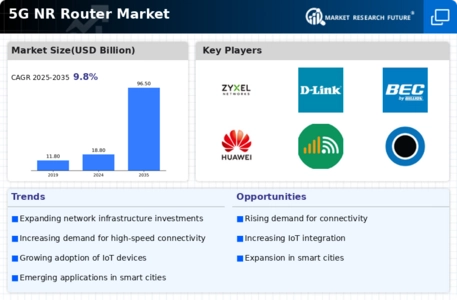Emergence of Smart Cities
The emergence of smart cities represents a transformative trend within the Global 5G NR Router Market Industry. Urban areas are increasingly adopting smart technologies to improve infrastructure, enhance public services, and promote sustainability. The deployment of 5G networks is essential for the functioning of smart city applications, such as traffic management, energy efficiency, and public safety. As cities invest in these technologies, the demand for 5G NR routers is likely to increase, supporting the connectivity needs of various smart applications. This trend is expected to contribute to the market's growth trajectory, with projections indicating a significant expansion in the coming years.
Market Growth Projections
The Global 5G NR Router Market Industry is poised for substantial growth, with projections indicating a market value of 96.5 USD Billion by 2035. This anticipated growth is underpinned by various factors, including technological advancements, increasing consumer demand, and government support. The market is expected to experience a CAGR of 16.03% from 2025 to 2035, reflecting the ongoing transition towards 5G technology. As industries continue to adopt 5G solutions, the demand for high-performance routers will likely escalate, driving innovation and competition among manufacturers. This growth trajectory underscores the importance of 5G NR routers in shaping the future of connectivity.
Expansion of IoT Applications
The proliferation of Internet of Things (IoT) devices significantly influences the Global 5G NR Router Market Industry. As more devices become interconnected, the need for reliable and high-speed internet connectivity becomes paramount. The market is expected to grow substantially, with projections indicating a value of 96.5 USD Billion by 2035. This growth is fueled by sectors such as healthcare, manufacturing, and smart homes, where real-time data exchange is essential. The ability of 5G NR routers to support a vast number of simultaneous connections enhances their appeal, making them indispensable for businesses aiming to leverage IoT technologies.
Increased Mobile Data Consumption
The Global 5G NR Router Market Industry is significantly impacted by the rising mobile data consumption globally. As consumers increasingly rely on mobile devices for streaming, gaming, and online communication, the demand for high-capacity routers capable of handling large data volumes intensifies. This trend is expected to drive market growth, with the industry projected to reach 18.8 USD Billion in 2024. The ability of 5G NR routers to provide seamless connectivity and support high-definition content delivery is crucial in meeting consumer expectations. Consequently, service providers are investing in advanced router technologies to enhance user experiences and maintain competitive advantages.
Government Initiatives and Investments
Government initiatives play a crucial role in the advancement of the Global 5G NR Router Market Industry. Many countries are investing heavily in 5G infrastructure to enhance national competitiveness and drive economic growth. For instance, various governments are allocating funds to support the deployment of 5G networks, which in turn stimulates demand for 5G NR routers. These initiatives not only promote technological innovation but also create a favorable regulatory environment for market players. As a result, the industry is poised for robust growth, with a projected CAGR of 16.03% from 2025 to 2035, reflecting the increasing commitment to 5G technology.
Rising Demand for High-Speed Connectivity
The Global 5G NR Router Market Industry experiences a surge in demand for high-speed connectivity, driven by the increasing reliance on digital services across various sectors. As businesses and consumers seek faster internet speeds, the market is projected to reach 18.8 USD Billion in 2024. This demand is particularly evident in urban areas, where smart city initiatives are being implemented, necessitating robust network infrastructure. The integration of 5G technology enables enhanced data transfer rates, low latency, and improved network reliability, which are crucial for applications such as IoT, autonomous vehicles, and augmented reality.




















